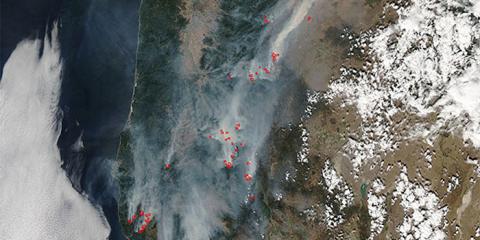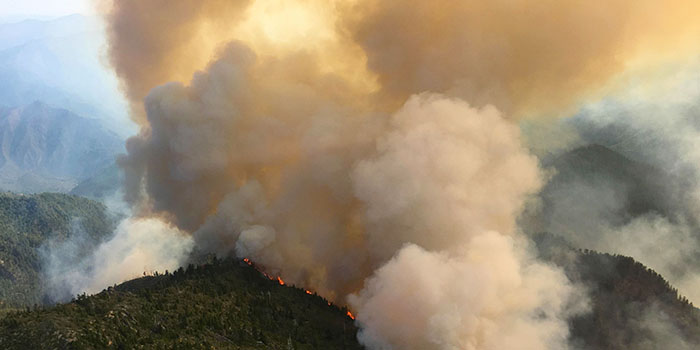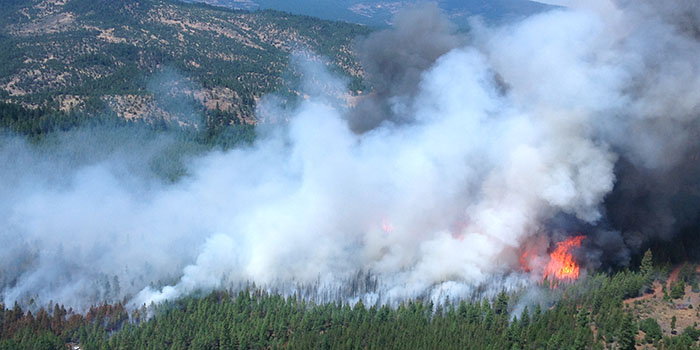We smelled the smoke. Now it’s time to wake up.
February 06, 2018
In the summer of 2017, Oregonians woke up and smelled not coffee, but the pungent aroma of a thick haze of smoke that had descended across the state.
After a mild 2016 wildfire season, following record seasons the previous two years, Oregon’s luck ran out. Despite the efforts of firefighting crews regarded as among the best for private and public lands, lightning and human-caused wildfires ravaged the state’s forests and rangelands, making 2017 one of the worst wildfire seasons on record.
News headlines quickly captured the expense of fighting all those fires, but fire suppression represents just a fraction of the true cost of wildfire. There are huge impacts to air quality and health, school athletics, travel and tourism, employment and the economy, transportation, and iconic Oregon economic sectors such as the state’s wine and timber industries.
No single state agency is charged with documenting these costs, so the Oregon Forest Resources Institute gathered what information is currently available from media reports, individual interviews and research. We released our 25-page report in January. You can read a four-page summary here.
What we found is that the causes of wildfire are complex. Fire does play an important role in Oregon’s fire-adapted forest ecosystems. We can never be “fire-free.” But it’s now up to the state’s leaders, scientists and policymakers to have a crucial conversation and chart a course where Oregonians can co-exist with fire while simultaneously mitigating its impact on our economy and our health. By looking at the non-suppression costs, the OFRI report highlights why the need for such a conversation has now reached the critical stage.
The 2017 wildfires encroached on the daily lives of our state’s 4 million residents. Hazardous smoke drifted into small communities and major metropolitan areas alike. Breathing was difficult and caused many school athletic contests, as well as outdoor concerts and performances, to be canceled. Restaurants, retailers and other businesses lost revenue. Highways closed. Workers took long detours to get to their jobs, or stayed home. More than 7,000 people were evacuated from their homes due to fire danger.

Air quality and health
Wildfire smoke, a mix of particulate matter and gases, irritates the eyes, nose, throat and respiratory system, and can be inhaled into the deepest part of the lungs, according to the Oregon Health Authority.
At high levels, it’s dangerous even for healthy people, but it is especially dangerous for those with chronic health conditions, people older than 65, infants, children and pregnant women.
During the 2017 fire season, most of Oregon experienced hazardous levels of smoke, including 160 days that were considered Unhealthy for Sensitive Groups (USG), compared to none of those days in 2016 and fewer than half that many at the USG level in 2015.
This led to a variety of impacts, including:
- Increased emergency room visits – 86 percent higher than expected in the first week of September, according to the Oregon Health Authority.
- Cancellations of high school sporting events. Oregon high schools canceled dozens of football and soccer games from August through October – more than four times as many as were canceled in 2016 and 2015.
Travel, tourism and employment
According to the most recent figures, Oregon’s tourism industry employs about 110,000 people and generates $11.3 billion in economic impact for the state. In 2017, wildfires hit the industry with blazing force, keeping away tourists and the money they would spend in Oregon. According to the Oregon Employment Department, hundreds of tourism workers received early layoff notices.
Among the high-profile impacts of the wildfire smoke that blanketed the state were:
- The Oregon Shakespeare Festival in Ashland canceled nine performances in 2017, a direct loss of $373,000. About 85 percent of its audience is composed of tourists. In an average year, the festival adds about $130 million to the local economy. It announced that it will trim 12 positions from its 2018 budget after last year’s revenue shortfall.
- Cycle Oregon canceled its annual ride, a premier cycling event for the state. The ride travels through different parts of rural Oregon each year, amounting to $450,000 spent in local communities.
- The Sisters Folk Festival was canceled. This annual community festival attracts 5,000 visitors to central Oregon and generates $1.2 million. The proceeds would have benefited arts education programs.

Transportation
For nearly three weeks, all drivers were detoured off Interstate 84 when the highway was closed from Hood River to Troutdale because of fire danger. This translated to long detours for commuters and trucking companies – a hard economic hit.
About 20 percent of the 28,000 vehicles that travel the highway each day are freight trucks delivering goods, according to the Oregon Department of Transportation. Longer travel distances meant extra time and cost.
In central Oregon, U.S. Highway 20 experienced traffic congestion. In the Brookings area, Highway 101 was closed off and on during the fire season, affecting 18,000 vehicles a day.
Rural and social impacts
The fires also impacted other areas of community life, including:
- Oregon’s timber industry and its workers faced reduced log supply at plywood plants, temporary mill shutdowns, restrictions on logging because of dry conditions, and losses of heavy equipment and timber due to fire
- limits on recreational opportunities, with popular outdoor attractions and wilderness areas remaining closed because of fire damage
- a drain on the resources of nonprofit organizations that provided support for Oregonians displaced from their homes by fires

How do we move forward?
Wildfires caused by lightning and people wreaked havoc on Oregon’s forests and rangelands in 2017, and the impact on Oregon life was far-reaching.
It’s clear that, with 665,000 acres burned in 2017, the state lost timber that supports the wood products industry, as well as other forest benefits such as outdoor recreation, beautiful scenery, wildlife habitat and healthy watersheds.
It’s also obvious that fires are costly in terms of suppression efforts. During the peak of the 2017 fire season in Oregon, some 8,000 firefighters were working to put out wildfires across the state. In total, it cost $454 million to fight all those fires.
Yet the costs don’t stop there. The blazes and the smoky air they produced also took a toll on people’s health, and on their ability to safely spend time outside. Event cancellations, highway closures and residential evacuations affected the economy, including significant losses to tourism, trucking and recipients of goods, among other industries.
Oregon is not alone in suffering worsening fire seasons. In the western United States, the length of the average fire season has grown by 78 days since 1970, from five months to more than seven months. The questions loom: Is this the new normal? What economic and human effects did Oregon experience in 2017, and what similar impacts will wildfires have going forward?
As a society we need to ask: How we co-exist with a fire-based forest ecosystem? What do we want from our forests in the future? Finding the answers will be hard and perhaps unpleasant, but the alternative of simply waiting to suffer through another fire season similar to 2017’s would be kicking the can down the road.
Are there options in the forest management toolbox to address some of the problems caused by wildfires? And if so, how do we overcome obstacles to effectively using forest management tools in at-risk communities and ecosystems?
This all begs one more question: Where do we go from here?
For the forest,
Paul Barnum
Executive Director
